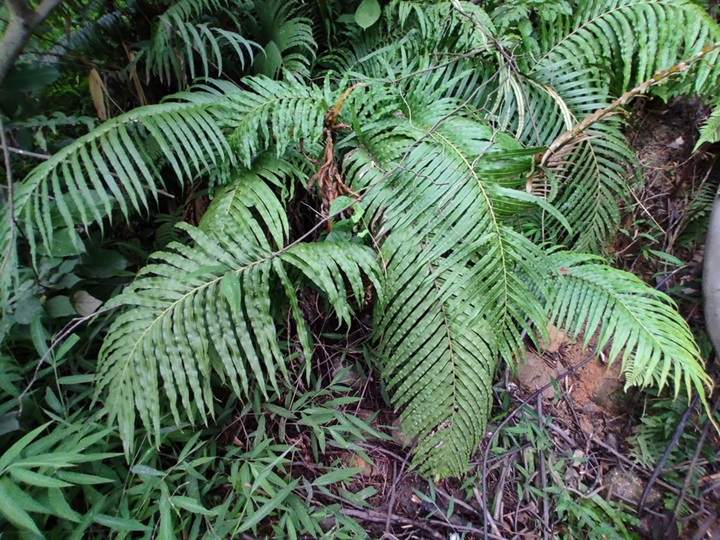Unlocking Strategic Value from Blechnum orientale, the ordinary-looking paku lipan or centipede fern.

Photo Credit: POWO (2025) “Plants of the World Online” facilitated by the Royal Botanic Gardens, Kew
By Dr Mohd Safar Hasim
The Blechnum orientale fern, known locally as Paku Lipan (centipede fern), looks rather ordinary, and few pay it much attention.
However, recent scientific breakthroughs in China are set to change all that.
In a landmark study published in Environmental Science & Technology in November 2025, researchers from the Chinese Academy of Sciences unveiled a biological mechanism with transformative implications for sustainable mining and environmental remediation.
The study revealed the fern’s extraordinary ability to absorb rare earth elements (REEs) from soil and biomineralise them into chemically pure, non-radioactive monazite nanoparticles within its tissues.
This is the first time REEs have been observed forming a mineral inside a living plant under ambient conditions.
Using advanced microscopy and spectroscopy, the research team identified monazite nanoparticles forming within the fern’s vascular bundles and epidermal cells. Remarkably, these particles were free from radioactive thorium and uranium — elements typically associated with geological monazite. The biomineralisation process appears to serve as a detoxification mechanism, enabling the fern to sequester potentially harmful REEs in a stable, inert form that protects its cellular integrity.
Far from being a mere scientific curiosity, this discovery opens a revolutionary pathway for “phytomining” — the use of plants to extract valuable minerals from the earth.
Unlike conventional mining, which often relies on high temperatures, acid leaching, and generates radioactive by-products, the fern’s biomineralisation occurs at ambient temperature and pressure. This low-impact, nature-based method offers a cleaner, safer alternative for REE recovery, particularly in regions where environmental degradation and community resistance have hindered traditional extraction.
Strategic Potential for Malaysia: A Native Solution
Malaysia stands at a pivotal moment in its rare earth development strategy. The discovery of REE biomineralisation in the Blechnum orientale fern offers a uniquely local and sustainable solution.
This fern is not only native but also abundant in several REE-bearing regions, including:
* Selangor and Perak: Lowland forests and post-mining landscapes with known monazite and ion-adsorption clay deposits
* Johor: Roadside and secondary forest zones near industrial corridors
* Sabah and Sarawak: Upland areas with mineral-rich soils and legacy mining sites
The natural distribution of Blechnum orientale across these zones means Malaysia can deploy phytomining without introducing foreign species — reducing ecological risk and accelerating implementation. By planting and managing this fern in REE-contaminated soils or mine tailings, Malaysia can:
* Recover valuable REEs while remediating degraded land
* Reduce reliance on chemical leaching and high-temperature processing
* Create green jobs and community-based restoration programs
* Position itself as a global leader in sustainable REE extraction
A Green Circular Model: Restoration Meets Recovery
The environmental remediation potential of the Blechnum orientale fern is particularly compelling. By cultivating this fern in contaminated soils, Malaysia could simultaneously clean up degraded land and recover valuable REEs.
This dual-purpose approach supports a “green circular model” of resource recovery, where environmental restoration and economic extraction are mutually reinforcing.
The fern acts as a natural concentrator, absorbing dilute REEs and converting them into usable mineral forms. This reduces the need for chemical processing, minimises ecological disruption, and aligns with Malaysia’s broader goals of circular economy development and climate resilience.
Beyond Mining: Ecological and Cultural Significance
Beyond its role in REE recovery, the Blechnum orientale fern offers additional ecological and cultural
benefits:
* Soil Stabilisation: Its root systems help prevent erosion and improve soil structure
* Biodiversity Conservation: Supports habitat connectivity and microclimate regulation in secondary forests
* Ethnobotanical Value: Used in indigenous medicine for treating skin ailments and fevers
Its presence in tropical reforestation efforts enhances both ecological resilience and cultural continuity. As a keystone species, it contributes to the health of forest ecosystems while preserving traditional knowledge systems.
From Discovery to Deployment: What Malaysia Must Do
To fully harness the potential of the Blechnum orientale fern, Malaysia must invest in interdisciplinary research and pilot-scale implementation. Key steps include:
* Mapping REE-Contaminated Zones: Identify priority areas for phytomining and remediation
* Optimising Cultivation Protocols: Develop best practices for fern propagation and REE uptake
* Developing Low-Impact Extraction Techniques: Innovate methods to recover monazite from biomass without harming the environment
* Fostering Collaboration: Engage botanists, geochemists, environmental engineers, and policymakers in joint initiatives
* Promoting Public Education: Ensure phytomining efforts are inclusive, transparent, and culturally sensitive
Community engagement will be essential. By involving local stakeholders in planting, monitoring, and harvesting, Malaysia can build trust and ensure that phytomining benefits are equitably shared.
A Fern-Led Future for Green Extraction
The discovery of REE biomineralisation in Blechnum orientale represents a paradigm shift in mineral recovery and environmental stewardship. For Malaysia it offers a rare convergence of ecological integrity, technological innovation, and cultural relevance.
By embracing this fern not only as a botanical marvel but as a strategic asset, Malaysia can lead the world in forging a cleaner, greener path for critical mineral extraction — rooted in nature, science, and sustainability.
The views expressed here are entirely those of Dr Mohd Safar Hasim, a Council Member of the Malaysian Press Institute (MPI)